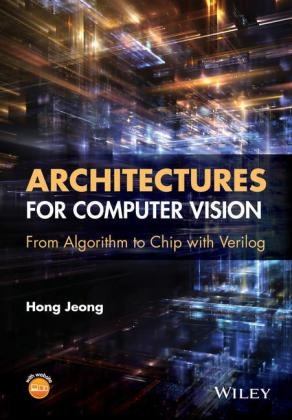En savoir plus
This book provides comprehensive coverage of 3D vision systems, from vision models and state-of-the-art algorithms to their hardware architectures for implementation on DSPs, FPGA and ASIC chips, and GPUs. It aims to fill the gaps between computer vision algorithms and real-time digital circuit implementations, especially with Verilog HDL design. The organization of this book is vision and hardware module directed, based on Verilog vision modules, 3D vision modules, parallel vision architectures, and Verilog designs for the stereo matching system with various parallel architectures.
* Provides Verilog vision simulators, tailored to the design and testing of general vision chips
* Bridges the differences between C/C++ and HDL to encompass both software realization and chip implementation; includes numerous examples that realize vision algorithms and general vision processing in HDL
* Unique in providing an organized and complete overview of how a real-time 3D vision system-on-chip can be designed
* Focuses on the digital VLSI aspects and implementation of digital signal processing tasks on hardware platforms such as ASICs and FPGAs for 3D vision systems, which have not been comprehensively covered in one single book
* Provides a timely view of the pervasive use of vision systems and the challenges of fusing information from different vision modules
* Accompanying website includes software and HDL code packages to enhance further learning and develop advanced systems
* A solution set and lecture slides are provided on the book's companion website The book is aimed at graduate students and researchers in computer vision and embedded systems, as well as chip and FPGA designers. Senior undergraduate students specializing in VLSI design or computer vision will also find the book to be helpful in understanding advanced applications.
Table des matières
About the Author xi
Preface xiii
Part One VERILOG HDL
1 Introduction 3
1.1 Computer Architectures for Vision 3
1.2 Algorithms for Computer Vision 6
1.3 Computing Devices for Vision 7
1.4 Design Flow for Vision Architectures 8
Problems 9
References 10
2 Verilog HDL, Communication, and Control 11
2.1 The Verilog System 11
2.2 Hello, World! 12
2.3 Modules and Ports 14
2.4 UUT and TB 17
2.5 Data Types and Operations 17
2.6 Assignments 20
2.7 Structural-Behavioral Design Elements 22
2.8 Tasks and Functions 25
2.9 Syntax Summary 27
2.10 Simulation-Synthesis 29
2.11 Verilog System Tasks and Functions 30
2.12 Converting Vision Algorithms into Verilog HDL Codes 33
2.13 Design Method for Vision Architecture 36
2.14 Communication by Name Reference 38
2.15 Synchronous Port Communication 40
2.16 Asynchronous Port Communication 44
2.17 Packing and Unpacking 50
2.18 Module Control 51
2.19 Procedural Block Control 55
Problems 61
References 62
3 Processor, Memory, and Array 63
3.1 Image Processing System 63
3.2 Taxonomy of Algorithms and Architectures 64
3.3 Neighborhood Processor 66
3.4 BP Processor 68
3.5 DP Processor 70
3.6 Forward and Backward Processors 73
3.7 Frame Buffer and Image Memory 74
3.8 Multidimensional Array 76
3.9 Queue 77
3.10 Stack 79
3.11 Linear Systolic Array 81
Problems 87
References 88
4 Verilog Vision Simulator 89
4.1 Vision Simulator 90
4.2 Image Format Conversion 91
4.3 Line-based Vision Simulator Principle 98
4.4 LVSIM Top Module 100
4.5 LVSIM IO System 102
4.6 LVSIM RAM and Processor 105
4.7 Frame-based Vision Simulator Principle 109
4.8 FVSIM Top Module 111
4.9 FVSIM IO System 112
4.10 FVSIM RAM and Processor 116
4.11 OpenCV Interface 122
Problems 125
References 128
Part Two VISION PRINCIPLES
5 Energy Function 131
5.1 Discrete Labeling Problem 132
5.2 MRF Model 132
5.3 Energy Function 135
5.4 Energy Function Models 136
5.5 Free Energy 138
5.6 Inference Schemes 139
5.7 Learning Methods 141
5.8 Structure of the Energy Function 142
5.9 Basic Energy Functions 144
Problems 147
References 147
6 Stereo Vision 151
6.1 Camera Systems 151
6.2 Camera Matrices 153
6.3 Camera Calibration 156
6.4 Correspondence Geometry 158
6.5 Camera Geometry 162
6.6 Scene Geometry 163
6.7 Rectification 165
6.8 Appearance Models 167
6.9 Fundamental Constraints 169
6.10 Segment Constraints 171
6.11 Constraints in Discrete Space 172
6.12 Constraints in Frequency Space 176
6.13 Basic Energy Functions 179
Problems 180
References 180
7 Motion and Vision Modules 183
7.1 3D Motion 184
7.2 Direct Motion Estimation 187
7.3 Structure from Optical Flow 188
7.4 Factorization Method 191
7.5 Constraints on the Data Term 192
7.6 Continuity Equation 197
7.7 The Prior Term 197
7.8 Energy Minimization 201
7.9 Bin
A propos de l'auteur
Hong Jeong,
Pohang University of Science and Technology, South Korea
Résumé
This book provides comprehensive coverage of 3D vision systems, from vision models and state-of-the-art algorithms to their hardware architectures for implementation on DSPs, FPGA and ASIC chips, and GPUs. It aims to fill the gaps between computer vision algorithms and real-time digital circuit implementations, especially with Verilog HDL design.

